Rehabilitation following your hip fracture
The information on this page is a general guide to help you to have the best recovery following your hip fracture. If you have any questions after reading this page, please ask a member of staff involved in your care. A hip fracture is a break at the top of the leg bone, near where your leg and body meet. Your consultant or a member of the team will have discussed with you whether you have had a total or half hip replacement, or screws to fix your fractured hip.
On this page
-
Therapy
-
Your rehabilitation
-
How will exercises benefit my hip following an injury?
-
Exercises
-
Will exercises harm my new hip?
-
Assessment
-
Going home
-
Getting in and out of a car
-
At home
-
Walking
-
Sticks
-
Frequently asked questions
-
Contact information
-
Further information
-
Returning walking aids and equipment
Therapy
Therapy plays an important part in your recovery and regaining strength (rehabilitation), this is to help:
- increase muscle strength around your hip.
- improve your posture and walking.
- encourage a return to normal activities.
- maximise your balance to reduce the risk of falls.
- support and plan your discharge.
Your rehabilitation
Your rehabilitation will be tailored to you, but we generally aim to help you out of bed on the first day after the operation.
As your strength and confidence grows, you may progress from using an appropriate mobility aid, such as a wheeled frame, to walking sticks. You will also practice using stairs, if required. Your therapist will work with you to achieve this.
How will exercises benefit my hip following an injury?
- By helping you reach your highest level of function and independence.
- By helping you to regain the movement, strength and control around your hip.
Exercise can help you return to your normal activities and hobbies.
Exercises
You will be guided through the following exercises by a member of the therapy team while you are in hospital. You should continue doing the exercises by yourself while on the ward and when you go home, little and often during the day.
Seated exercises
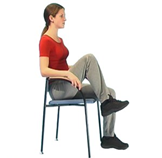
Exercise 1
Lift your leg up off the seat keeping your knee bent. Return to the starting position. Repeat this exercise 5 times on both legs.
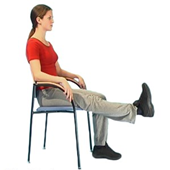
Exercise 2
Sitting on a chair with your thigh fully supported, tighten your thigh muscle and straighten your knee until your leg is fully straight. Lower slowly back to starting position. Repeat this exercise 5 times on both legs.
Standing exercises
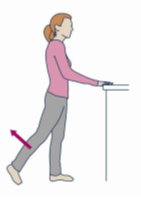
Exercise 1
Stand straight and hold on to the back of a sturdy chair or work surface for support. Take your injured leg backwards keeping your knee straight. Try not to tilt your body forwards during the exercise. Repeat this exercise 5 times.
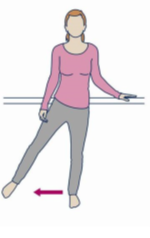
Exercise 2
Stand straight and hold onto the back of a sturdy chair or work surface for support. Take your injured leg out to the side keeping your knee straight. Return to your original starting point. Repeat this exercise 5 times.
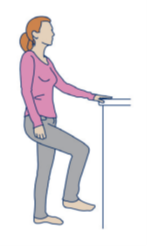
Exercise 3
Stand straight and hold onto the back of a sturdy chair or work surface for support. Lift your injured leg up in front of you keeping your knee bent. Repeat this exercise 5 times.
Will exercises harm my new hip?
Your hip will be sore when you first start therapy. Walking and exercises will not harm your hip in any way, but will help to reduce post-operative pain and stiffness in your joint.
It is important to take regular pain relief while your hip feels sore. This is for your comfort and to enable you to carry out the exercises with greater ease.
Therapists will look at every aspect of your life, including your home environment, your ability to carry out personal and domestic activities during the day and any support you have at home.
Depending on the type of surgery you have had, you may have certain restrictions on movements. You may hear these restrictions being referred to as hip precautions. We will discuss any restrictions with you.
Occasionally we may need to teach you how to complete tasks differently to make sure that you are as safe and independent as possible. We will give you equipment where necessary to help you achieve this.
After your operation, you may struggle with carrying out everyday tasks which may have been easy for you before your surgery. The therapist will help you to identify your goals and work with you to reach your maximum level of independence with these everyday tasks.
Assessment
Some of the areas that the therapist may assess and provide support with are:
Personal care
The therapist may need to issue you with long handled dressing aids to help you to get yourself dressed. You will be shown how to use these and you can practice if needed while in hospital. It is important that you have a set of clothes and shoes with you in hospital. This is so that you can start getting yourself dressed as you would at home. This is all part of your rehabilitation.
You will be advised not to have a bath or a shower if it is located over the bath, until you feel confident to do so. It is recommended that you strip wash at the basin until then. You can wash your legs and feet with long handled aids if you have nobody able to assist you.
If you have a shower cubicle, you should step in with your non-operated leg first and step out with your operated leg first. It is recommended that you use a non-slip shower mat.
Transfers
The therapist will assess your ability to get in and out of bed, on and off the toilet and in and out of a chair. If this is something that you are struggling with, we will teach you techniques to help you to manage safely.
We will take into account the type of furniture you have at home and can provide adaptive equipment if required.
Home environment
The therapist will discuss your home environment with you. This is to identify any areas where you may need further rehabilitation, additional support or adaptive equipment.
As part of arranging your discharge home in a safe and timely manner, we may need to know the heights of certain pieces of furniture at home.
If necessary, we will discuss this with you and leave a form for your family/carer to complete and return to us on the ward. Please let us know as soon as possible if you have no one available to do this.
Going home
Stairs
If you need to, you will be taught how to manage stairs before you go home.
When going upstairs you should place the un-operated leg on the step first, followed by your operated leg and finally your walking stick or elbow crutch. If there is one, use the banister/handrail with your free hand.
When going downstairs, you should place your walking stick or elbow crutch on the lower step first, followed by your operated leg and then your un-operated leg. Again, use the banister/handrail with your free hand if you are able.
Getting in and out of a car
Try to break up long car journeys to avoid sitting for too long.
To get into the car:
- Slide the front passenger seat as far back as possible. Reclining the seat slightly may also help.
- Stand with your back to the seat. Slowly lower yourself to the edge of the seat.
- Push yourself back towards the driver’s seat until your operated leg is supported on the passenger seat.
- Turn carefully and slide your legs into the well of the car so that you are now facing forwards. You may need some help to lift your legs over the door sill.
To get out of the car, follow the above steps in reverse.
If you have had an operation, it is advised that you do not drive for a minimum of 6 weeks. After this time, you should contact your GP for advice.
At home
Once you are back at home, you will want to get the most out of your surgery. The following information is designed to help you get back to normal activities as soon as possible.
Walking
It is important that you take regular pain relief to help you walk comfortably. You may need to take pain relief for a few months but this is normal.
We recommend that you slowly build up your level of walking as you feel more able. Assess this on a daily basis. This includes: distance, terrain (ground), gradient (incline/slope) and pace.
Sticks
If you were discharged home using 2 walking sticks and feel safe and confident, try using 1 walking stick. We suggest using the walking stick in the opposite hand to your hip surgery.
It is important that you do not limp or lean heavily on 1 walking stick. If you find yourself limping, we advise you to return to using 2 walking sticks until you are stronger.
There are no guidelines as to when you can manage without a walking stick. Be guided by your own ability and confidence.
If you go home with elbow crutches, please check at your next clinic appointment before using just 1 crutch.
Frequently asked questions
I am taking regular pain relief but I do not feel this is enough. What should I do?
If your pain is not well controlled and if your sleep is very disturbed, you need to ask for advice from your GP or pharmacist.
You should be guided by how you feel on a daily basis for when you can resume the following activities:
When can I drive my car?
You should be able to return to driving after 6 weeks. You must be able to carry out an emergency stop and you must inform your insurance company.
When can I do the housework?
Light housework such as dusting may be resumed when you are discharged home, increasing slowly to heavier housework such as vacuuming when you feel able.
When can I resume sexual activities?
Be aware that in the first 6 weeks following surgery the muscles and tissues around your hip are healing. After hip surgery, it is a good idea to change positions to those which are most comfortable for you.
When can I return to swimming?
You can return to swimming after 6 weeks as long as your wound is completely clean, dry and healed.
When can I return to work?
Depending on what work you do and with advice from your GP, you can return to work when you feel ready.
When can I walk the dog?
Once you are confidently walking with 1 stick, you may resume walking your dog. Walking over un-even ground is good exercise for your hip but be careful of potential hazards, such as being pulled over by your dog.
When can I return to gardening?
You may return to gentle, light gardening as soon as you feel comfortable. Resume heavier activities, for example lawn mowing, digging and kneeling after 6 weeks as you feel able.
When can I play golf?
Return to playing golf when you are independently mobile (without sticks). To make sure the muscles around your hip are fully strengthened you are advised to wait 3 months after your surgery before playing golf.
Contact information
If after leaving hospital you have any concerns about your surgery, your first point of contact should be the ward where you had your surgery. If you feel that your problem requires more urgent or out of hours attention, please contact your GP or NHS 111 for advice.
Ward 2A
Gloucestershire Royal Hospital
Tel: 0300 422 6776
Ward 3A
Gloucestershire Royal Hospital
Tel: 0300 422 5005
Ward 3B
Gloucestershire Royal Hospital
Tel: 0300 422 5006
NHS 111
Tel: 111
If your concerns relate to your mobility, exercise, your ability to cope at home or with the equipment provided, please contact your ward therapist on:
Ward Therapist
Gloucestershire Royal Hospital
Tel: 0300 422 5316
Monday to Friday, 8:00am to 4:30pm
Further information
NHS Choices
Website: www.nhs.uk/conditions/hip-fracture/
Returning walking aids and equipment
Please remember to return any walking aids or equipment you were given, to Gloucestershire Equipment Loan Service once you have finished using them.
Gloucestershire Equipment Loan Service
To return or arrange for equipment to be picked up, please contact the number below:
Tel: 01452 520 438
Gloucestershire Royal and Cheltenham General Hospitals do not have the facility to store used equipment.